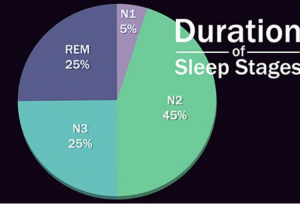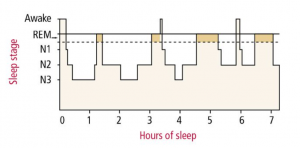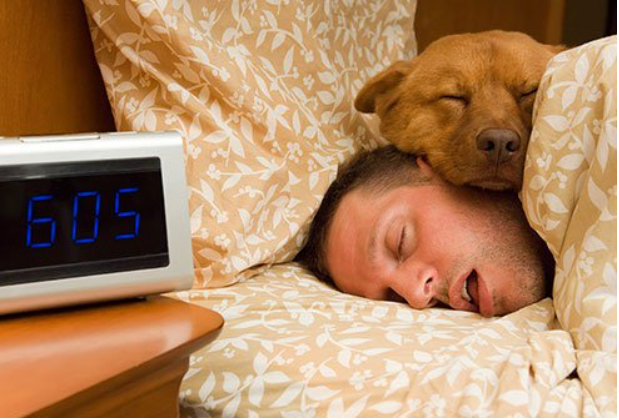Sleep is absolutely essential for your health.
However, when life gets busy, it’s often the first thing to get neglected or sacrificed.
Sleep is more than just a time for your body and mind to rest. In fact, while you’re asleep, your body is hard at work.
During this time, your body rebuilds muscles you’ve worn down during the day and cleans away harmful plaques and waste that are produced in the brain. These are vital processes that keep both your mind and body running properly.
Your mind also processes and responds to important emotions and experiences from the day and commits them to memory.
Sleep is also essential to regulating your emotions. In fact, being sleep deprived for just one night can increase your emotional response to negative feelings by 60%.
Not to mention, a lack of it makes it difficult for your body to regulate essential things like appetite control, your immune system, good metabolic function and your ability to maintain a normal body weight.
Stages and Cycles of Sleep
Certain brain structures and chemicals produce the states of sleeping and waking. For instance, a pacemaker-like mechanism in the brain regulates circadian rhythms. (“Circadian” means “about a day.”) This internal clock, which gradually becomes established during the first months of life, controls the daily ups and downs of biological patterns, including body temperature, blood pressure and the release of hormones.
Circadian rhythms make people’s desire for sleep strongest between midnight and dawn, and to a lesser extent in mid-afternoon.
Sleep factors:
- Light. Exposure to light at the right time helps keep the circadian clock on the correct time schedule. However, exposure at the wrong time can shift sleep and wakefulness to undesired times. The circadian rhythm disturbances and sleep problems that affect up to 90% of blind people demonstrate the importance of light to sleep/wake patterns.
- Time. As a person reads clocks, follows work and train schedules, and demands that the body remain alert for certain tasks and social events, there is cognitive pressure to stay on schedule.
- Melatonin. Levels of melatonin begin climbing after dark and ebb after dawn. The hormone induces drowsiness, and scientists believe its daily light-sensitive cycles help keep the sleep/wake cycle on track.
Scientists divide sleep into two major types:
1. Quiet sleep or non-REM sleep;
2. Dreaming sleep or REM sleep;
Non-REM sleep:
To an extent, the idea of “dropping” into sleep parallels changes in brain-wave patterns at the onset of non-REM sleep. When you are awake, billions of brain cells receive and analyze sensory information and coordinate behavior by sending electrical impulses to one another. If you’re fully awake, an EEG records a messy, irregular scribble of activity. Once your eyes are closed and your brain no longer receives visual input, brain waves settle into a steady and rhythmic pattern of about 10 cycles per second. It is the alpha-wave pattern, characteristic of calm, relaxed wakefulness.
Unless something disturbs the process, you will proceed smoothly through the three stages of quiet (non-REM) sleep:
1.1. Stage N1– In making the transition from wakefulness into light sleep, you spend about 5 minutes in stage N1 sleep. On the EEG, the predominant brain waves slow 4-7 cycles per second. Body temperature begins to drop, muscles relax, and eyes often move slowly from side to side. People in stage N1 sleep lose awareness of their surroundings, but they are easily jarred awake. However, not everyone experiences stage N1 sleep in the same way: if awakened, one person might recall being drowsy, while another might describe having been asleep.
1.2. Stage N2- This first stage of true sleep lasts 10 to 25 minutes. Your eyes are still, and your heart rate and breathing are slower than when awake. Your brain’s electrical activity is irregular. Large, slow waves intermingle with brief bursts of activity called sleep spindles, when brain waves speed up for roughly half a second or longer. Scientists believe that when spindles occur, the brain disconnects from outside sensory input and begins the process of memory consolidation (which involves organizing memories for long-term storage). The EEG tracings also show a pattern called a K-complex, which scientists think represents a sort of built-in vigilance system that keeps you poised to awaken if necessary. K-complexes can also be provoked by certain sounds or other external or internal stimuli. Whisper someone’s name during stage N2 sleep, and a K-complex will appear on the EEG. You spend about half the night in stage N2 sleep.
1.3. Stage N3 (deep sleep, or slow-wave sleep)- Eventually, large, slow brain waves called delta waves become a major feature on the EEG, and you enter deep sleep. Breathing becomes more regular. Blood pressure falls, and the pulse slows to about 20% to 30% below the waking rate. The brain is less responsive to external stimuli, making it difficult to wake the sleeper.
Deep sleep seems to be a time for your body to renew and repair itself.
Blood flow is directed less toward your brain, which cools measurably. At the beginning of this stage, the pituitary gland releases a pulse of growth hormone that stimulates tissue growth and muscle repair. Researchers have also detected increased blood levels of substances that activate your immune system, raising the possibility that deep sleep helps the body defends itself against infection.
Normally, young people spend about 20% of their sleep time in stretches of deep sleep lasting up to half an hour, but deep sleep is nearly absent in most people over age 65. Deep sleep plays a large part in restoring alertness and fills an essential role in a person’s optimal functioning.
Dreaming (REM) sleep:
Dreaming occurs during REM (rapid eye movement) sleep, which has been described as an “active brain in a paralyzed body”. Your brain races, thinking and dreaming, as your eyes dart back and forth rapidly behind closed lids. Your body temperature rises. Your blood pressure increases, and your heart rate and breathing speed up to daytime levels. The sympathetic nervous system, which creates the fight-or-flight response, is twice as active as when you’re awake. Despite all this activity, your body hardly moves, except for intermittent twitches; muscles not needed for breathing or eye movement are quiet.
Just as deep sleep restores your body, scientists believe that REM or dreaming sleep restores your mind, perhaps in part by helping clear out irrelevant information. Earlier studies found that REM sleep facilitates learning and memory.
About 3-5 times a night, or about every 90 minutes, you enter REM sleep
The first such episode usually lasts for only a few minutes, but REM time increases progressively over the course of the night. The final period of REM sleep may last a half-hour.
If you’re deprived of REM sleep and then allowed a subsequent night of undisturbed sleep, you will enter this stage earlier and spend a higher proportion of sleep time in it—a phenomenon called REM rebound.

During the night, a normal sleeper moves between different sleep stages in a fairly predictable pattern, alternating between REM and non-REM sleep. When these stages are charted on a diagram, called a hypnogram (see Figure 1), the different levels resemble a drawing of a city skyline. Sleep experts call this pattern sleep architecture.
In a young adult, normal sleep architecture usually consists of four or five alternating non-REM and REM periods. Most deep sleep occurs in the first half of the night. As the night progresses, periods of REM sleep get longer and alternate with stage N2 sleep. Later in life, the sleep skyline will change, with less stage N3 sleep, more stage N1 sleep, and more awakenings.

Each stage of sleep in your sleep cycle offers different benefits. However, deep sleep (the time when the body repairs itself and builds up energy for the day ahead) and mind and mood-boosting REM sleep are particularly important. You can ensure you get more deep sleep by avoiding alcohol, nicotine, and being woken during the night by noise or light.
It’s estimated that nearly one-third of adults and two-thirds of high school students don’t get enough sleep each night.
Unfortunately, not getting enough good-quality sleep can cause much more harm than simply feeling tired.
In Part 2 we will discuss the consequences of not getting enough sleep and how much sleep we need each night.
References:
https://www.helpguide.org/harvard/biology-of-sleep-circadian-rhythms-sleep-stages.htm
https://www.emedicinehealth.com/body_brain_sleep_cycle/article_em.htm
https://www.ncbi.nlm.nih.gov/pmc/articles/PMC5449130/
https://www.healthline.com/nutrition/how-much-sleep-you-need#section1

Leave a Reply